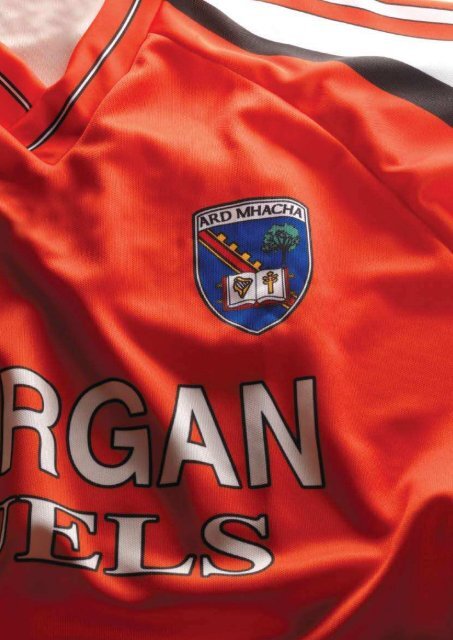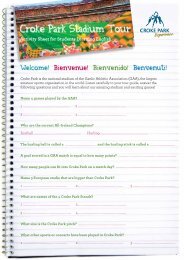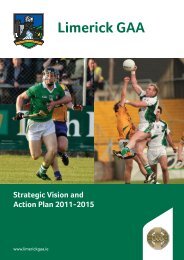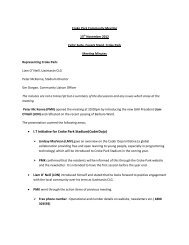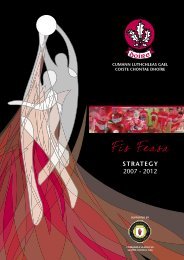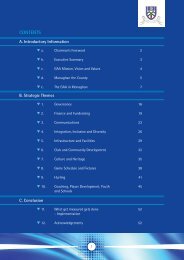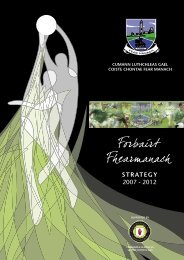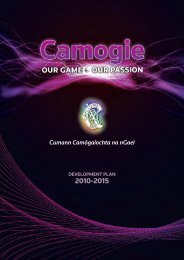Ulster GAA Strategic Vision and Action Plan - Croke Park
Ulster GAA Strategic Vision and Action Plan - Croke Park
Ulster GAA Strategic Vision and Action Plan - Croke Park
Create successful ePaper yourself
Turn your PDF publications into a flip-book with our unique Google optimized e-Paper software.
Title to go hereSub Title to go hereOur <strong>Plan</strong>ning Contexts<strong>Ulster</strong> the ProvinceThe nine Counties of <strong>Ulster</strong> are home to 1.95m people,one-third of the population of the isl<strong>and</strong> of Irel<strong>and</strong>.<strong>Ulster</strong> is second only to Leinster (2.29m) <strong>and</strong> is largerthan both Munster (1.17m) <strong>and</strong> Connacht (0.51m)combined in population terms. It is home to Irel<strong>and</strong>’ssecond city, Belfast, an urban area of 0.58m people, aswell as its fourth city, Derry, where nearly 0.1m peoplenow live. Belfast for example is now larger in populationterms than the entire Province of Connacht.Irel<strong>and</strong>’s Population<strong>Ulster</strong>33%Munster20%Leinster38%Connacht9%<strong>Ulster</strong> has grown by more than 0.2m or 11% over the pastquarter-century <strong>and</strong> is projected to increase by another5% to some 2.1m by 2017. Within that growth howeveris an important internal dynamic where the under 16proportion of the population will fall from 24% to 20%;the working age proportion will grow from 61% to 62%;<strong>and</strong> those of pensionable age will increase from 15%to 18%.Among the changes <strong>and</strong> shifts <strong>Ulster</strong> is currentlyexperiencing, <strong>and</strong> will continue to experience, <strong>and</strong> whichare particularly relevant to the work of ComhairleUladh are:• Growing urbanisation, with four-people-in-every-tennow living in settlements of more than 20,000 people• Increased economic prosperity leading to greaterwealth, both community <strong>and</strong> personal … butsimultaneous concentrated incidences of deprivation<strong>and</strong> disadvantage in many urban <strong>and</strong> rural areas• Growing concerns about personal health <strong>and</strong> wellbeing,many related to sedentary lifestyles• Less robust social structures with a weakening ofcommunity infrastructures <strong>and</strong> a lowering of thelevels of social capital• Political progress leading to more attention beingpaid to inclusion <strong>and</strong> equality issues but asimultaneous political legacy which poses manychallenges for everyone.At the same time large tracts of <strong>Ulster</strong> rely on “oldeconomy” industries <strong>and</strong> are more acutely subject toeconomic downturns. For many <strong>Ulster</strong> communitiesthe practice of having to go elsewhere for workremains strong.The <strong>Ulster</strong> of 2015 <strong>and</strong> Beyond“Shaping our Future” is the regional developmentstrategy for the north. It is built around an urban hub;transport corridor; <strong>and</strong> regional gateway concept whichsees Belfast; Derry; Craigavon; <strong>and</strong> the other main urbancentres increasing in significance. Many stakeholdershowever are suspicious as to its impact on the ruralcommunities of the six Counties.The National Spatial Strategy meanwhile places the three<strong>Ulster</strong> Counties in its Border Region where developmentwill be driven by the urban centres of Letterkenny/Derry;Sligo; <strong>and</strong> Dundalk with Cavan <strong>and</strong> Monaghan playinglesser roles. It stresses the need for strengtheningof small towns <strong>and</strong> villages; rural diversification; <strong>and</strong>environmental protection.If implemented, both strategies will drive forward thecentralisation of facilities; resources; <strong>and</strong> investmentacross <strong>Ulster</strong>. This will have major implications forpeople’s links with <strong>and</strong> underst<strong>and</strong>ing of place …something which underpins the entire <strong>GAA</strong> ethos;its structures; <strong>and</strong> its work. Within this, the growingsignificance of Dublin <strong>and</strong> Belfast within the isl<strong>and</strong> haveconsequences for other communities right across <strong>Ulster</strong>.The <strong>GAA</strong> in <strong>Ulster</strong>Just as in the rest of Irel<strong>and</strong>, the <strong>GAA</strong> is <strong>Ulster</strong>’s largestsporting <strong>and</strong> cultural organisation. It has a membershipof some 250,000 people, approximately 120,000 ofwhom are active participants in the games. Gaelicgames comprise football; hurling; camogie; h<strong>and</strong>ball; <strong>and</strong>rounders, for men <strong>and</strong> women, boys <strong>and</strong> girls. In additionto these the <strong>GAA</strong> focuses on Irish cultural activities,supporting the language as well as Irish song; music; art;drama <strong>and</strong> dance.14Comhairle Uladh CLGLifelong promotion of Gaelic Games, Culture, Community <strong>and</strong> Family<strong>Ulster</strong> <strong>GAA</strong> <strong>Strategic</strong> <strong>Vision</strong> <strong>and</strong> <strong>Action</strong> <strong>Plan</strong> 2009-2015 15


